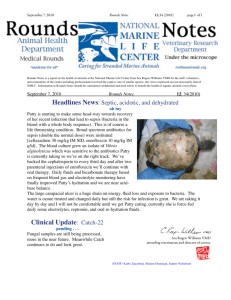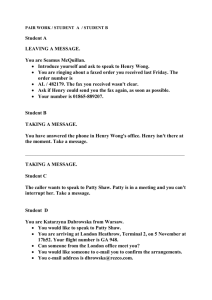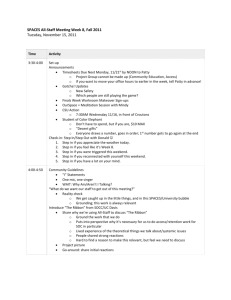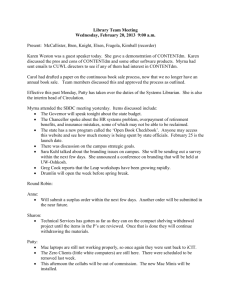Patty Snider's work in the Nursing Simulation Lab
advertisement
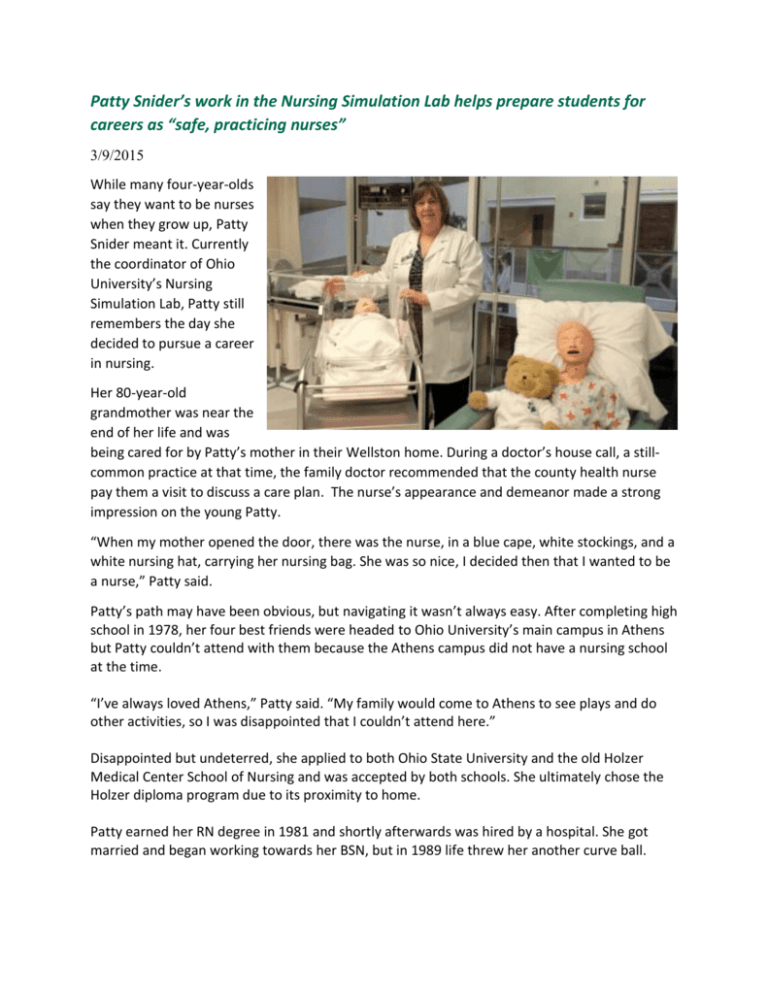
Patty Snider’s work in the Nursing Simulation Lab helps prepare students for careers as “safe, practicing nurses” 3/9/2015 While many four-year-olds say they want to be nurses when they grow up, Patty Snider meant it. Currently the coordinator of Ohio University’s Nursing Simulation Lab, Patty still remembers the day she decided to pursue a career in nursing. Her 80-year-old grandmother was near the end of her life and was being cared for by Patty’s mother in their Wellston home. During a doctor’s house call, a stillcommon practice at that time, the family doctor recommended that the county health nurse pay them a visit to discuss a care plan. The nurse’s appearance and demeanor made a strong impression on the young Patty. “When my mother opened the door, there was the nurse, in a blue cape, white stockings, and a white nursing hat, carrying her nursing bag. She was so nice, I decided then that I wanted to be a nurse,” Patty said. Patty’s path may have been obvious, but navigating it wasn’t always easy. After completing high school in 1978, her four best friends were headed to Ohio University’s main campus in Athens but Patty couldn’t attend with them because the Athens campus did not have a nursing school at the time. “I’ve always loved Athens,” Patty said. “My family would come to Athens to see plays and do other activities, so I was disappointed that I couldn’t attend here.” Disappointed but undeterred, she applied to both Ohio State University and the old Holzer Medical Center School of Nursing and was accepted by both schools. She ultimately chose the Holzer diploma program due to its proximity to home. Patty earned her RN degree in 1981 and shortly afterwards was hired by a hospital. She got married and began working towards her BSN, but in 1989 life threw her another curve ball. “Professors for the BSN program went to the places of employment at that time and I was working with a professor when I began to feel sick. Everyone assumed it was due to the procedure we were conducting, but after having tests run I learned that I was expecting,” Patty said. Feeling she wouldn’t be able to do justice to the three priorities of parenthood, studies, and her job, Patty made the decision to put her BSN on hold. Over the next several years, Patty’s nursing career evolved as her son grew. She worked in a job-sharing position while her son was young, which allowed her to work one week and have the following week off, she worked night shift for a period of time, and also worked as an acute care nurse on a medical surgery team. In 2005, Patty made the decision that her son was old enough that she could focus on advancing her career. In order to move into an administrative role, she enrolled in Ohio University’s Health Services Administration Program and earned her Bachelor of Science in Health (BSH) degree in 2006. Soon after, she accepted a position as department head of a hospital-based homecare agency. In 2006, Patty also decided to complete her BSN. She enrolled in the Ohio University School of Nursing’s online RN to BSN program which provided the flexibility she needed to maintain her career commitments. Patty completed her BSN in 2008. That same year she had another life-changing moment that she remembers clearly. She was reading the Columbus Dispatch and saw that a traditional BSN program was coming to Ohio University’s Athens campus. She remembers saying out loud, “It’s about time,” and thinking to herself that she might be able to contribute to the program in some way. “As a hiring manager, I was sometimes concerned about the caliber of nurses I saw and I thought there was something I could hopefully give,” she said. Patty completed her MSN degree at Ohio University in 2012 and has been employed in the CHSP Nursing Simulation Lab for almost three years. Patty says she loves working in the lab and that the 300 students who practice their skills there each year love it too. “The simulation lab is a safe environment for students to take what they learn in class and during skills instruction and apply that learning on a mannequin as part of a scenario we create.” The high-tech mannequins, available in different genders and ages, can sweat, breathe, cry, bleed and talk, and possess vital signs including blood pressure, pulse, and heart rate just as a real person would. While Patty is responsible for a plethora of activities in the simulation lab, from scheduling classes to creating and conducting simulation scenarios, her favorite aspect is “moulage,” which involves making the mannequins appear consistent with the scenario being practiced. Patty has made realistic looking emesis (vomit) from coffee grounds to simulate a patient with a GI bleed, and has created various wounds and bodily fluid simulations, but notes that everything in the lab is totally fabricated and safe. Patty believes the simulation lab is helping to prepare nurses who are better equipped than in the past. “I learned to give injections on an orange and we inserted NG tubes on each other. Now, a computer even tells students whether they’re disinfecting the infusion site long enough. And what I love about the mannequins is that when someone comes into the hospital with a heart murmur or pneumonia, our students already know what that sounds like. I didn’t get that experience until I was a practicing RN,” she said. The lab also features an IV simulator, medicine dispensing equipment similar to what is used in hospitals, and task trainers that allow nursing students to practice procedures such as accessing a port located under the patient’s skin using a small needle, which was a procedure Patty had to do for the first time on a real patient. As for future hopes for the lab and its students, Patty is optimistic that another lab will be constructed in the not-too-distant future and that students will continue to embrace the technology available to them. “I hope the students realize that this is the place to learn and make mistakes. I want them to learn from the mistakes they’ve made here and be safe practicing nurses,” Patty said. More information about the simulation lab can be found on the College’s School of Nursing website.
